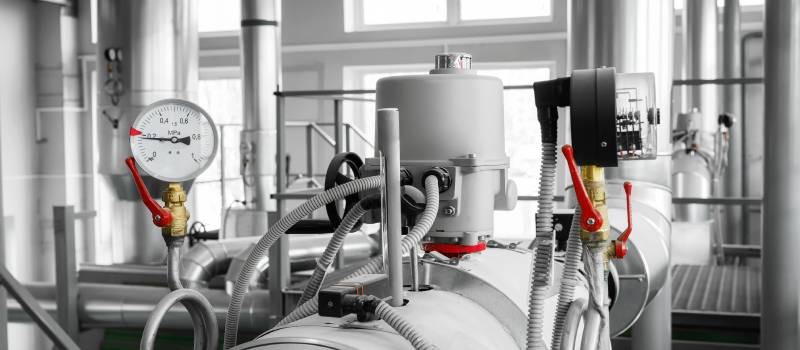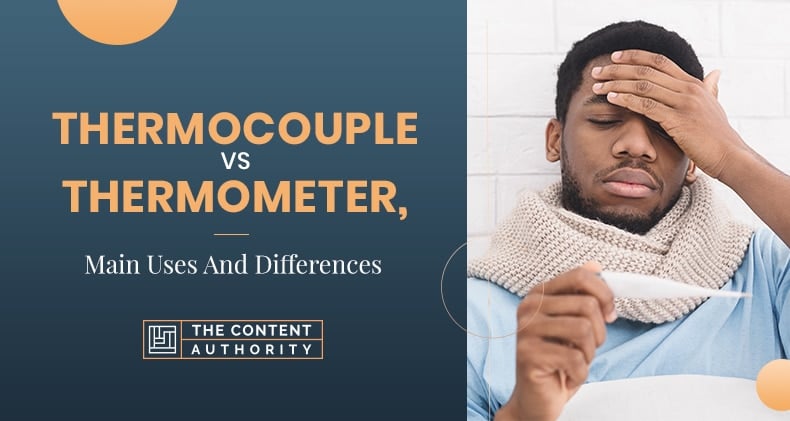What equipment is used to measure temperature? It’s safe to say that we are all familiar with what a thermometer is. However, are there any other similar tools? Are they all thermometers with a fancy name?
A thermocouple is an electrical device with two different conductors forming an electrical junction at different temperatures. A thermometer is a device we use to measure temperature. A thermocouple is a thermoelectric device, and a thermometer is an instrument for measuring temperature.
The thermometer has two elements. The first component is a temperature sensor. These, for example, could be one that uses mercury-in-glass or the thermal sensor in an infrared thermometer. The second method refers to the conversion of temperature into a numerical value. For example, scales or digital clocks.
Thermocouples are used in science and industry. The thermocouple is the go-to tool for temperature measurement in big ovens, turbines, engines, and many other industrial processes. Thermocouples are in our homes and offices as part of the thermostat and flame sensors in security devices.
Thermometers are primarily found in meteorology, medicine, and scientific works to monitor each process.
The Greeks developed the principles of a thermometer around two thousand years ago. During the 17th century, the thermoscope was combined with a scale to create the thermometer we know today.
The thermoscope is a device that can exhibit temperature changes. The thermoscope consists of a tube where liquid rises and falls when the temperature changes. The liquid increases at higher temperatures and falls when it is lower.
A thermoscope was used to demonstrate the changes in the air density caused by changes in temperature. An egg-sized jar with a large thin tube was heated by hands and placed upside down in a recipient with water; by removing the hands, the liquid rose through the tube.
What Is The Origin Of A Thermocouple?

Thermocouples are the most famous temperature sensors. They are used in hospitals during testing for vehicle engines, boilers, water heaters, and most safety features that deal with temperature. Thermocouples are also an extraordinary tool for the food industry. They are used as a thermometer and aid in milk pasteurization.
Temperature sensors have been around for almost a century. Measuring the temperature by voltage was discovered by accident in 1822 by a physician named Thomas Seebeck.
Thomas Seebeck, born in Estonia in 1770, discovered that a voltage occurs when there is a junction at the spot where two different metals meet. The measurement of temperature is based on the function of the voltage. Seebeck tried this experiment intending to deflect a compass magnet.
Present-day thermocouples still use this discovery to measure temperature in different situations. Like everything else, thermocouples have evolved throughout the years. We have found that some metals are better than others for a more accurate temperature reading. That seemingly minor discovery in 1822 paved the way for a whole industry of temperature sensors. Thermocouples are found in many forms and with an extensive line of variations.
Different types of metals and features are used as temperature sensors in a thermocouple. As a result, in order to choose a thermocouple that fits your needs, you need to understand the elements it might contain.
What Is The History Of The Thermometer? Who Invented It?
A couple of centuries ago, scientists found out they could measure temperature by using glass recipients. This device uses different liquids that tend to expand when warm and contract when they cool down. This is the aforementioned thermoscope. The thermoscope was the first type of thermometer, and for the experiment, alcohol and mercury were the most frequent liquids used. The earliest kind of thermoscope used water.
The first recorded thermoscope was developed by the Italian inventor Galileo Galilei in 1593. Galileo’s thermoscope used a glass bulb inside an open tube. In 1612, Italian inventor Santorio Santorio made his own version of the thermoscope. This new thermoscope used a scale with numbers, but it was still very primitive.
The first closed glass tube came in 1654. Created by Ferdinand II, the Grand Duke of Tuscany, this thermocouple contained mostly alcohol and had another numerical scale. It wasn’t very accurate. The earliest thermometers similar to current models date back to the 1700s. The German-Polish physicist Daniel Fahrenheit created the modern thermometer in 1709. This thermometer had a closed tube with a numerical scale that he called “the Fahrenheit scale.”
The earliest Fahrenheit thermometer contained alcohol, but in 1714 he developed a version of the thermometer made out of mercury while using the same scale. He determined the freezing water to be at 32°F., and its boiling point at 212°F., the human body temperature was set at 98.6°F. Later that century, the Swedish astronomer Anders Celsius developed his version of the numerical scale to measure temperatures. He called it the Celsius, also known as the Centigrade scale.
The Celsius or Centigrade Scale is based on a scale that goes from zero to one hundred. Freezing water is 0°C while boiling water is 100°C. On this scale, body temperature is 37°C.
British doctor Thomas Clifford Allbutt invented the first medical thermometer in 1867. It took five to seven minutes to measure someone’s temperature, and the thermometer was six inches long. This thermometer contained alcohol and mercury and was considered to be the most accurate to date. Doctor Allbutt’s thermometer remained unchanged for almost a century. After World War II (1939-1945), countries started developing modern versions of this thermometer. They started using infrared technology, electrical circuits, and numerical screens to measure the temperature more efficiently and accurately.
Nowadays, thermometers use electrical sensors to measure temperature using the same numerical scale created in the 1700s by Daniel Fahrenheit and Anders Celcius.

What Is The Range Of A Thermocouple?
Range and accuracy depend on the tool’s alloys, the elaboration of the sensors, and whether it is liquid, solid, or gas to determine what temperature is being measured.
Thermocouples come in many different ways. They can have other types of metals and measurements. The most common is “Base Metal” thermocouples. The ones used to measure higher temperatures are known as “Noble Metal” thermocouples. The range of measurements in these thermocouples is a max temperature of 370°C or 700°F for the Base Metal, and 1260°C or 2300°F for the Noble Metal. Choosing the right one implies knowing what your measurement requirements are.
How Do Temperature Sensors Work?

Temperature sensors are devices that measure temperature via electrical signals. A temperature sensor is created by two metals, which generate voltage when they notice a temperature change. In most manufacturing processes of temperature devices, these instruments are vital components. Temperature is one of the most crucial physical measurement types in all industrial applications.
Different types of temperature sensors can be used in various forms of temperature management. There are two types of temperature sensors: contact and non-contact.
Contact temperature sensors
The Resistance Temperature Detector (RTD) measures the resistance temperature of an element. The RTD uses platinum, nickel, or copper as its metals. Platinum is the most accurate and the most expensive. Both the thermocouple and thermometer are contact-temperature sensors.
Non-Contact temperature sensor
Infrared sensors are used to determine temperature from afar by measuring thermal radiation from an object.
Thermal and Infrared Sensors are the best known non-contact temperature sensors. These tools are readily available during a pandemic to measure a person’s body temperature from a distance.
Examples
Now that we have covered the most important facts about the words, it’s time to see their usage in writing.
- The inspector verified that the thermocouple was working correctly.
- Please use the backup thermocouple we have in storage. The new one is malfunctioning.
- The quality manager for the kitchen division stated that the iron thermocouples that we bought last year were not worth the money we spent on them.
- Don’t forget to connect the thermocouple to the galvanometer, and please try to keep the temperature steady this time.
- This new thermocouple replaces copper-nickel conductors with chromel-alumel conductors.
- Please make sure that you bring the thermometer from your mom’s house.
- Katherine hid the thermometer. She hates the way it feels on her skin.
- I will buy you a thermometer tomorrow. The one you loaned me broke.
- I’m not sure that this thermometer reads temperature accurately.
- The thermometer that nurse Jacky used was dirty.
Conclusion
The main difference we have found is that a thermocouple is a thermoelectric device, and a thermometer is an instrument that measures temperature. Additionally, they both measure temperatures differently. A thermocouple requires a voltage, and an electrical charge of sorts, created by a junction of two metals. The thermometer, especially the medical one, has a more direct approach. Thermocouples are mainly found in industrial creations, while the thermometer has been a vital medical tool.
Shawn Manaher is the founder and CEO of The Content Authority. He’s one part content manager, one part writing ninja organizer, and two parts leader of top content creators. You don’t even want to know what he calls pancakes.

